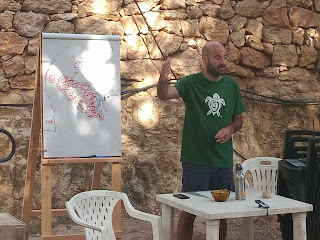On the 18th of September, the fourth day of the Summer School MeditHerity - Mobility and Heritage in the Mediterranean started with the lecture of professor Stefano Malatesta. After it, we met Legambiente and Turtle Rescue members, and we found out some interesting points of contact emerging from these confrontations. First of all, the fact that insularity and isolation are not synonymous.
Being on an island at the centre of the South-West, we realised that there are multiple borders and relationships. If politically, Lampedusa island fits Europe, geologically, it is part of the African plate.
The island presents itself as a system that acts as a connection point between different dynamics and flows. A complex system where the interaction between different agents, human and non-human, are in constant relation to each other.
The island-system brings out the close and regular interconnections between people, animals, and the environment in its geographical limitation. Elements of an ecosystem in which limits and opportunities are in the sea, depending on the observer’s perspective.
For this reason, we have perceived it as fundamental to find a balance functional to the coexistence, especially in an island context. In fact Lampedusa receives nourishment from the sea; it bases its current economic system on it; it interacts with the surrounding world through it.
Observing the island’s reality and listening to the stories of the people who live and work on it, we realise that the interpretative tools and theoretical perspectives often risk being too limited to deal with the complexity of the multiple dynamics existing. As social scientists, we are aware of the gap between our theories and the worldview of the locals and how, in everyday life, categories are subject to a permeability that is not immediately identifiable. But, who has the right to be called ‘local’ in Lampedusa? We have met many people who are not natives but are, nevertheless, highly engaged in daily practice dynamics surrounding the island and/or its history.

One of the aspects, and more generally of the language, that particularly struck us was the correlation between the concepts of ‘rescue’ and ‘emergency’ in their multiple meanings. Saving turtles, rescuing migrant people, and preserving the environment appear to be ethically and pragmatically inseparable elements of the island’s single image and attitude.
If, on the one hand, we are shown the importance of taking care of the island because, through its rescue, the ecosystem can be maintained, on the other hand the island itself performs rescue actions towards the outside that can have repercussions on the internal balances.
In a context of limited size, it is also evident that there is a « double-edged » between accessibility and preservation, human dignity (of migrant people and/or workers) and tourist system, economy and environment. How to strike a balance? What are the elements worthy of consideration? Who has the right to set it?













































